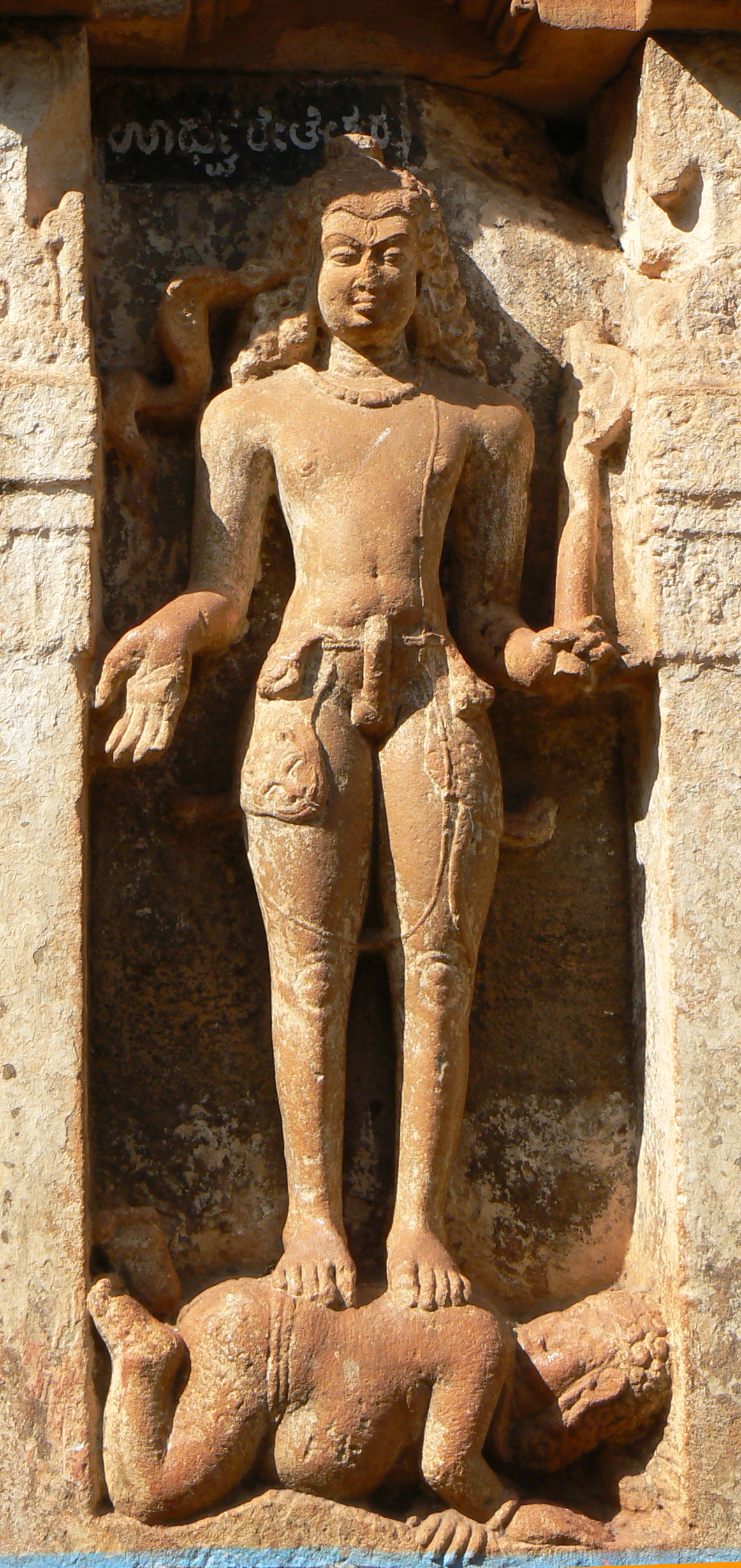|
Pashupata
Pashupata Shaivism (, sa, पाशुपत) is the oldest of the major Shaivite Hindu schools. The mainstream which follows Vedic Pasupata penance are 'Maha Pasupatas' and the schism of 'Lakula Pasupata' of Lakulisa. There is a debate about pioneership of this schism and the Goan school of Nakulish darshan believes that Nakulish was pioneer and Lakulish and Patanjalinath were his disciples while Gujarat school believes that Nakulish and Lakulish are one. Sarvadarśanasaṅgraha written by Vidyaranya (sometimes also known as Madhavacharya) mentions it as "Nakulish Darshan" not as "Lakulish Darshan". Both sub schools are still active in their own areas. The philosophy of the Pashupata sect was systematized by also called Nakulīśa) in the 2nd century CE. The main texts of the school are '' '' with Kauṇḍinya's ', and ' with Bhāsarvajña's '. Both texts were discovered only in the twentieth century. Prior to that, the major source of information on this sect was a chapter d ... [...More Info...] [...Related Items...] OR: [Wikipedia] [Google] [Baidu] |
Shaivism
Shaivism (; sa, शैवसम्प्रदायः, Śaivasampradāyaḥ) is one of the major Hindu traditions, which worships Shiva as the Supreme Being. One of the largest Hindu denominations, it incorporates many sub-traditions ranging from devotional dualistic theism such as Shaiva Siddhanta to yoga-orientated monistic non-theism such as Kashmiri Shaivism.Ganesh Tagare (2002), The Pratyabhijñā Philosophy, Motilal Banarsidass, , pages 16–19 It considers both the Vedas and the Agama texts as important sources of theology.Mariasusai Dhavamony (1999), Hindu Spirituality, Gregorian University and Biblical Press, , pages 31–34 with footnotesMark Dyczkowski (1989), The Canon of the Śaivāgama, Motilal Banarsidass, , pages 43–44 Shaivism developed as an amalgam of pre-Vedic religions and traditions derived from the southern Tamil Shaiva Siddhanta traditions and philosophies, which were assimilated in the non-Vedic Shiva-tradition. In the process of Sanskritisa ... [...More Info...] [...Related Items...] OR: [Wikipedia] [Google] [Baidu] |
Lakulisha
Lakulisha ( sa, लकुलीश ) (Etymology: लगुड (staff) or लकुट (mace) + ईश (lord) = meaning, the lord with a staff or mace or club or stick) was a prominent Shaivite revivalist, reformist and preceptor of the doctrine of the Pashupatas, one of the oldest sects of Shaivism. According to some scholars, Lakulisha is the founder of the Pashupata sect. While, another section argues that the Pashupata doctrine was already in existence before Lakulisha, and he was only its first formal preceptor. According to a tradition stated in the '' Linga Purana'', Lakulisha is considered as the 28th and the last avatar of Shiva and the propounder of Yoga system. According to the same tradition, Lakulisha had four disciples, viz., Kaurushya, Garga, Mitra and Kushika. According to another tradition mentioned in the ''Avanti Khanda'' of the ''Skanda Purana'', Lakulisha and his four disciples while passing Mahakalavana, installed a linga at that place, which was then kno ... [...More Info...] [...Related Items...] OR: [Wikipedia] [Google] [Baidu] |
Hindu Philosophy
Hindu philosophy encompasses the philosophies, world views and teachings of Hinduism that emerged in Ancient India which include six systems ('' shad-darśana'') – Samkhya, Yoga, Nyaya, Vaisheshika, Mimamsa and Vedanta.Andrew Nicholson (2013), Unifying Hinduism: Philosophy and Identity in Indian Intellectual History, Columbia University Press, , pages 2–5 In Indian tradition, the word used for philosophy is Darshana (Viewpoint or perspective), from the Sanskrit root ('to see, to experience'). These are also called the Astika (theistic) philosophical traditions and are those that accept the Vedas as an authoritative, important source of knowledge. Ancient and medieval India was also the source of philosophies that share philosophical concepts but rejected the Vedas, and these have been called (heterodox or non-orthodox) Indian philosophies. Nāstika Indian philosophies include Buddhism, Jainism, Chārvāka, Ājīvika, and others.P Bilimoria (2000), Indian Philosophy (E ... [...More Info...] [...Related Items...] OR: [Wikipedia] [Google] [Baidu] |
Pashupata-sutra
''Pashupata-sutra'' (IAST: Pāśupatasūtra) is a Sanskrit-language text regarded as revelation by the Pashupata Shaivite sect of ancient India. Dated between 400 and 550 CE, it is the earliest surviving text of the Pashupatas. Kauṇḍinya wrote a commentary called ''Panchartha-bhashya'' (IAST: ''Pañcārtha-bhāṣya'') on the text. Contents In the text, Shiva enters the dead body of a Brahmana, which comes to life as Lakulisha and imparts teachings to four disciples. According to the text, a Pashupata ascetic must be a Brahmana male who does not speak with people from the low castes or women. He transcends to a stage beyond the four stages of life of the Vedic tradition, by undertaking various observances in three stages. In the first stage, a person aspiring to be Pashupata ascetic should: * reside in the environs of a Shiva temple * bear the mark of a Pashupata ascetic, that is, the ashes in which he bathes thrice daily * worship with "song, dance, laughter, and mantra ... [...More Info...] [...Related Items...] OR: [Wikipedia] [Google] [Baidu] |
Shaiva Siddhanta
Shaiva Siddhanta () (Tamil: சைவ சித்தாந்தம் "Caiva cittāntam") is a form of Shaivism that propounds a dualistic philosophy where the ultimate and ideal goal of a being is to become an enlightened soul through Shiva's grace. It draws primarily on the Tamil devotional hymns written by Shaiva saints from the 5th to the 9th century, known in their collected form as ''Tirumurai''. Meykandadevar (13th century) was the first systematic philosopher of the school. The normative rites, cosmology and theology of Shaiva Siddhanta draw upon a combination of Agamas and Vedic scriptures. This tradition is thought to have been once practiced all over India. However the Muslim subjugation of North India restricted Shaiva Siddhanta to the south, where it merged with the Tamil Saiva movement expressed in the bhakti poetry of the Nayanmars.Flood, Gavin. D. 1996. An Introduction to Hinduism. P.168 It is in this historical context that Shaiva Siddhanta is commonly cons ... [...More Info...] [...Related Items...] OR: [Wikipedia] [Google] [Baidu] |
Pashupati
Pashupati (Sanskrit ''Paśupati''; devanagari पशुपति ) is a Hindu deity and an incarnation of the Hindu god Shiva as "lord of the animals". Pashupati is mainly worshipped in Nepal and India. Pashupati is also the national deity of Nepal. Etymology ''Paśupati'' or ''Pashupatinath'', means "Lord of all animals". It was originally it is also was the epithet of Rudra in the Vedic period. and it is one of the epithets of Shiva also. History The earliest claimed evidence of Pashupati comes from the Indus Valley civilization (3300 BCE to 1300 BCE), where the Pashupati seal has been said to represent a proto-Shiva figure. The Deity Pashupatinath is an avatar of Shiva, one of the Hindu Trinity. He is the male counterpart of Shakti. The five faces of Pashupatinath represent various incarnations of Shiva; Sadyojata (also known as Barun), Vamdeva (also known as Uma Maheswara), Tatpurusha, Aghor & Ishana. They face West, North, East, South and Zenith respectively, re ... [...More Info...] [...Related Items...] OR: [Wikipedia] [Google] [Baidu] |
Vaishnava
Vaishnavism ( sa, वैष्णवसम्प्रदायः, Vaiṣṇavasampradāyaḥ) is one of the major Hindu denominations along with Shaivism, Shaktism, and Smartism. It is also called Vishnuism since it considers Vishnu as the sole supreme being leading all other Hindu deities, i.e. ''Mahavishnu''. Its followers are called Vaishnavites or ''Vaishnava''s (), and it includes sub-sects like Krishnaism and Ramaism, which consider Krishna and Rama as the supreme beings respectively. According to a 2010 estimate by Johnson and Grim, Vaishnavism is the largest Hindu sect, constituting about 641 million or 67.6% of Hindus. The ancient emergence of Vaishnavism is unclear, and broadly hypothesized as a fusion of various regional non-Vedic religions with Vishnu. A merger of several popular non-Vedic theistic traditions, particularly the Bhagavata cults of Vāsudeva-krishna and ''Gopala-Krishna'', and Narayana, developed in the 7th to 4th century BCE. It was integrated w ... [...More Info...] [...Related Items...] OR: [Wikipedia] [Google] [Baidu] |
Movements In Ancient Indian Philosophy
Movement may refer to: Common uses * Movement (clockwork), the internal mechanism of a timepiece * Motion, commonly referred to as movement Arts, entertainment, and media Literature * "Movement" (short story), a short story by Nancy Fulda * ''The Movement'' (comics), a comic book by Gail Simone and Freddie Williams II * "Movement (운동, 運動)", a poem by Yi-sang Music Groups and labels * Movement (band), an Australian soul/ambient band * Movements (band), an American post-hardcore band Albums and EPs * ''Movement'' (9mm Parabellum Bullet album) * ''Movement'' (EP), an EP by BT * ''Movement'' (Joe Harriott album), or the title track * ''Movement'' (Inhale Exhale album) * ''Movement'' (New Order album) * ''Movement'' (The Gossip album) * ''Movements'' (album), by Booka Shade Songs * "Movement" (LCD Soundsystem song), 2004 * "Movement" (Kompany song), 2019 * "Movement" (Hozier song), 2019 * "Movement", a 1998 song by The Black Eyed Peas from '' ... [...More Info...] [...Related Items...] OR: [Wikipedia] [Google] [Baidu] |
Kashmir Shaivism
Kashmir Shaivism or Trika Shaivism, is a nondualist tradition of Shaiva-Shakta Tantra which originated sometime after 850 CE. Since this tradition originated in Kashmir it is often called "Kashmiri Shaivism". It later went on to become a pan-Indian movement termed "Trika" (lit. The Trinity) by its great exegete, Abhinavagupta, and particularly flourished in Odisha and Maharashtra.Wallis, Christopher; Tantra Illuminated, chapter II, The History of Śaiva Tantra Defining features of the Trika tradition are its idealistic and monistic ''Pratyabhijna'' ("Recognition") philosophical system, propounded by Utpaladeva (c. 925–975 CE) and Abhinavagupta (c. 975–1025 CE), and the centrality of the three goddesses Parā, Parāparā, and Aparā. While Trika draws from numerous Shaiva texts, such as the Shaiva Agamas and the Shaiva and Shakta Tantras, its major scriptural authorities are the ''Mālinīvijayottara Tantra'', the ''Siddhayogeśvarīmata'' and the ''Anāmaka-tantra.'' ... [...More Info...] [...Related Items...] OR: [Wikipedia] [Google] [Baidu] |
Indian Philosophy
Indian philosophy refers to philosophical traditions of the Indian subcontinent. A traditional Hindu classification divides āstika and nāstika schools of philosophy, depending on one of three alternate criteria: whether it believes the Vedas as a valid source of knowledge; whether the school believes in the premises of Brahman and Atman; and whether the school believes in afterlife and Devas. There are six major schools of Vedic philosophy— Nyaya, Vaisheshika, Samkhya, Yoga, Mīmāṃsā and Vedanta, and five major heterodox (sramanic) schools—Jain, Buddhist, Ajivika, Ajñana, and Charvaka. However, there are other methods of classification; Vidyaranya for instance identifies sixteen schools of Indian philosophy by including those that belong to the Śaiva and Raseśvara traditions.Cowell and Gough, p. xii.Nicholson, pp. 158-162. The main schools of Indian philosophy were formalised and recognised chiefly between 500 BCE and the late centuries of the Common Era. Com ... [...More Info...] [...Related Items...] OR: [Wikipedia] [Google] [Baidu] |
Spiritual Practices
A spiritual practice or spiritual discipline (often including spiritual exercises) is the regular or full-time performance of actions and activities undertaken for the purpose of inducing spiritual experiences and cultivating spiritual development. A common metaphor used in the spiritual traditions of the world's great religions is that of walking a path. Therefore, a spiritual practice moves a person along a path towards a goal. The goal is variously referred to as salvation, liberation or union (with God). A person who walks such a path is sometimes referred to as a wayfarer or a pilgrim. Religion Abrahamic religions Judaism Jewish spiritual practices may include prayer (including the Shema ''Shema Yisrael'' (''Shema Israel'' or ''Sh'ma Yisrael''; he , שְׁמַע יִשְׂרָאֵל ''Šəmaʿ Yīsrāʾēl'', "Hear, O Israel") is a Jewish prayer (known as the Shema) that serves as a centerpiece of the morning and evening Jewis ... and Amidah), reciting Berakhah, b ... [...More Info...] [...Related Items...] OR: [Wikipedia] [Google] [Baidu] |




